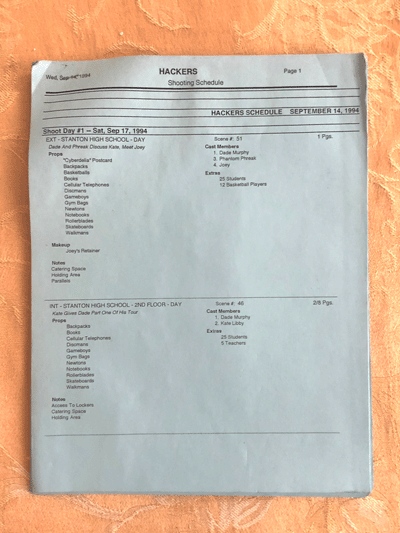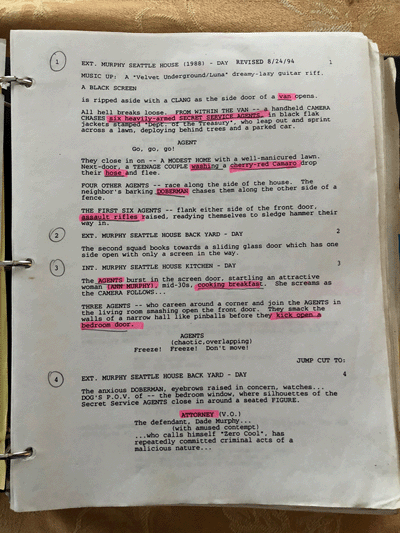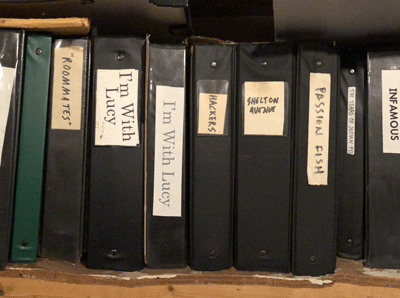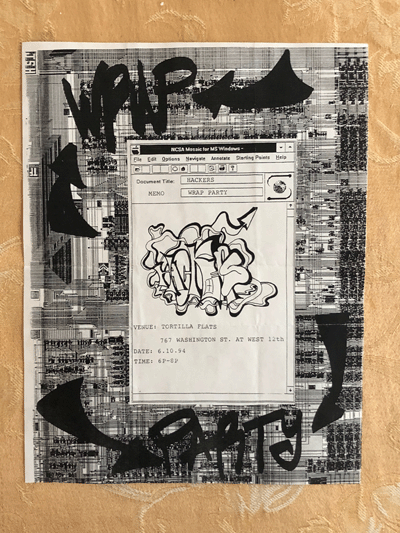HC:How long has it been since you've seen the film?
JB:
I saw it shortly after it came out. Then, I watched most of it a couple nights ago.
HC:
How did you initially get involved in the film?
JB:
Right before Hackers, I had just shot my first feature film. We wrapped in Las Vegas and took a red-eye back to New York on a Saturday night. While we were gone, our cat had escaped and returned, but infected the house with fleas. Sunday Morning, we returned to discover this, and had to set off two rounds of flea bombs. Finally, I think I got to bed after being up for over 24 hours.
The next morning I had a nine AM interview for Hackers. Then, when I got the job after the interview, they said, "Oh, and can you stay and work today?". It was really a beating. This was the exteriors being shot in New York. This was stuff that involved a lot of picture vehicles, a lot of police cars, it was the hard work.
When I went to England for a week to Pinewood (Studios) to introduce the props and try to just let them know what had been established, it was ridiculously easy in comparison because they'd already built all the sets. They would go, "Okay. We're going to go shoot the apartment." then, "Okay, company move." then, you just walk to another stage. The difference was just enormous.
HC:
You have the interview, the job is on the line, you got fleas going on at the house. [laughs] I can imagine how crazy that 24 to 48 hours must have been.
JB:
I think they were in a hurry to hire someone. I think I was a last minute hire. Obviously, I started right away.
HC:
For those not familiar with film, can you give a brief description of what a prop master does?
JB:
Yes. The definition is usually, they say, anything an actor touches. Now that doesn't count furniture and it doesn't count costumes. But props are responsible for guns, the coffee cup, things of that sort. We're also responsible for watches and wedding jewelry, though that's the only jewelry that we're responsible for. Also, in New York, props are responsible for picture vehicles.
HC:
Speaking of watches, [laughs] since that came up, most of the crew uses Casio or G-Shock watches with the exception of Phreak who seems to rock a Rolex. I'm assuming it's not a real Rolex.
JB:
No, that would have been a Canal Street Rolex. On Canal Street in New York, people sell a lot of counterfeit merchandise. That's where we tend to go to buy our fake Rolex watches.
HC:You've done a good deal of work as a prop master or in other areas of the art department, but you've also done some writing and directing work on
Criminals, and one coming up called
Strange Deal, which are your own films.
Talk a little bit about the differences between working in the art department versus writer/director.
JB:
What I really want to do is direct, as they say, but I have to make a living. It works out that about every 15 years, I get to go into debt and finance my own film, and then go back to work to climb out of it again.
I think it's a symbiotic relationship, if that's the right way to describe it, in that I think I'm a better prop guy because I think like a director.
I believe I'm sometimes better able to understand what directors want due to that experience of directing. Also, in my own mind, I think of myself as a director. That's what I trained to do. I haven't had much luck doing that, but I think it helps as a prop guy. Sometimes, it can get in the way if the director wants to be the director and they feel like I'm talking too much, or suggesting too much, or that kind of thing. It's not always the perfect balance, but I think the two things definitely reinforce each other.
I couldn't have directed the movies I did without having had the experience of working on all the movies I've worked on. I should clarify though, I didn't write Strange Deal. Dave Kunz was the writer of Strange Deal.
HC:
You're the director of Strange Deal, but you did write and direct Criminals. Is that right?
JB:
That's right.
HC:
Going back then to Hackers, What were your impressions once you understood where things were going with the concept and direction of the film?
JB:
At that time, I was one of those people that thought computers were for nerds, in a bad way. Like computers weren't cool. Anybody who was interested in computers wasn't cool.
Hackers, was the opposite of that. What's cool about these kids is their knowledge. It was funny to listen to some of the dialogue, like, "Does he "know" anything?" It's all about what you know. It's just so contrary to the popular idea of computers at that time. The thought that hackers were cool, It took me a minute, to wrap my head around that.
As a prop master, jobs (movies) almost always have some theme or aspect that you need to become familiar with. It was an awakening for me and an educational opportunity. I've learned a lot about computers since then, and probably as a result, got into working with computers earlier than I would have otherwise. So for me it was like, "Wow, this is really new territory." It was very unfamiliar.
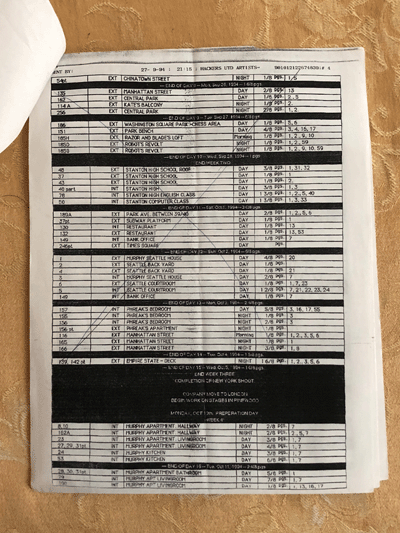
HC:
That being the case, did anything stand out as challenging or particularly interesting for you, from the props standpoint for the film?
JB:
A little bit of difficulty for me, I think, was the laptops and all that kind of thing. They really put all that stuff together in England and sent it to me. I didn't have very much to do with it.
I remember feeling very worried at the time just because usually, I know what I'm doing. My job is all about figuring out what I'm doing and knowing it very well. It was a little bit peculiar to be having it prepped by other people, then just have stuff handed off to me. It was all new to me. I mean, I knew what a modem was, but it was a weird time where technology was changing so fast.
HC:
The good majority the film was produced in the UK, and compared to New York, there's a lot of differences between US and UK standards, electrical outlets as an example. How does that particularly cause problems or make things interesting?
JB:
First, I think, you've got to hand it to John Beard, the designer, because I think really it's a cohesive movie. It doesn't look like it was made in two different places. I really felt it looked like it took place in New York. I think there were exterior scenes they shot in England that they got away with pretty well.
One example I can come up with is, the set decorator had bought an American bathtub and sent it to England for Dade's apartment interior. American bathtubs are four inches shorter than English bathtubs. That's why she did it, she wanted a proper American bathtub in the set. But when she got back to England, the carpenters had built a four-inch platform under the bathtub to bring it up to proper bathtub height according to English standards.
Another thing I noticed, the one thing that bothered me a little bit when watching the movie was the Coca-Cola bottle.
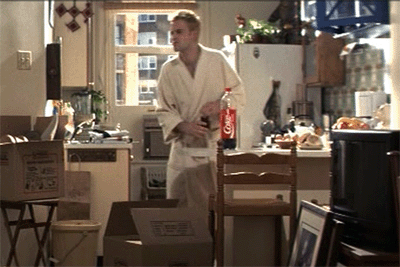
HC:
Just a little bit more between New York and London. How much collaboration was there with Keith Vowles (UK Prop Master) to keep things consistent?
JB:
There was a lot of collaboration in prep. I think they came on ahead of me. They obviously had an idea what the team's expectations and John's expectations were. There was a lot of back and forth. Then I went to England for a week to Pinewood and handed over the props, we worked with them showing them what we've shot and how it had played because there were little things like how the laptops were carried over people's shoulders and stuff like that.
It was very interesting in England at the time. It was very slow in Pinewood. They didn't have a lot of work.
I remember walking past a stage that was empty except for a whole bunch of flats against the wall and two carpenters standing there. They didn't have screw guns, by the way- they had hammers, they still used hammers- and they were standing there drinking tea. I remember I walked past maybe two hours later, not very much longer later, and they were still standing there drinking tea, but this enormous set had been put up behind them. These two guys had put up an enormous set with hammers.
HC:
You mentioned the prep. Now there was obviously a lot of prep done in New York as well, with some folks going and meeting 2600 and some actual hackers that were brought in to consult. Were you involved in that at all as well?
JB:
Yes, that was great. We worked with Emmanuel Goldstein who was around part of the time. There was a phone phreak, who was there. We went to a 2600 meeting that was in the atrium, I guess, or lobby at the hotel. The architecture was such that it was like a courtyard surrounded by reflective windows.
I remember sitting there and looking up around all of these windows and thinking, "which window is the FBI behind, spying on this meeting." [laughter] You knew they were somewhere. There was a cool thing when were I remember one of them had taken a Motorola brick phone, you know those big heavy phones, he took the battery off, used a piece of an aluminum gum wrapper to make a little tiny sort of connection between two points on the battery, and put the phone back together. We were able to listen to a phone conversation of some random guy explaining to his wife that he was going to be home soon, that he was at the bar but he was only having one drink. He totally had had many.
[laughter]
HC:
[laughs] That's insane!
JB:
It was amazing. Another thing that they have-- I'm sure you guys know about this, at that the time answering machines had a little remote that you'd carry with you and it made a tone or a series of tones, so your answering machine would recognize it. You could call your answering machine through a payphone, [beeping sound] and you could listen to your messages at home. These guys would reprogram that somehow.
You could go to a pay phone and go [beeping sound], and it would fool the payphone into thinking you inserted a quarter. So that you could make free calls at the phone booth.
One funny thing, there was one point where we were shooting above the observation deck on the Empire State Building, which is where all of the computers are that control the elevators and stuff. I remember the hackers would kind of circle- they started looking at them and rubbing their hand together. Security came and had us moved to a different section.
[laughter]
HC:
That had to have been a bit of a wake-up call. Obviously, its '94 computers themselves and certainly hacking were not well known to the mainstream. I'm sure it had to be very interesting to see some of what could be done.
JB:
Yes. That was really the fascinating part about that job, because those guys are serious. I remember talking to somebody on the phone. One of the consultants had hooked me up with a hacker. I think she was in South Carolina or something like that, and I think I was trying to get information about modems from her.
Then she said, "Hey, if you need modems..." it was like, they had access to stolen credit card numbers and basically just could fraudulently buy us whatever we wanted. Obviously we had to decline.
HC:
Getting back to props a little bit here then. You'd mentioned that you had gotten the watches and some of the other things there in New York. What other props were you specifically responsible for on your side for the film? And how long did it take to get everything together for filming?
JB:
I guess I had about four weeks or just a bit longer. The one prop that stands out, the most interesting prop was a laser listening device. It must have been at the end of the movie because I didn't see it when it was shot. But it was supposed to be something that looks something like a gun that you could point at a window and had headphones plugged into it and used a listening device. I worked with the surefire flashlight company and they built me this custom laser light. I thought that came out pretty cool.
HC:
It's unfortunate we didn't get to see that in the film. That would have been really interesting to see at the time. [laughs]
JB:
Did they cut it? It's not in the film? Man, those are the best props.
I still have my notebook at home. I'll dig it out and look into it and see what's in there. There might be some images still around.
HC:
That would be really cool. We have spent countless hours going to Google image search to try to figure out some of the various tech. It's incredible. We were actually able to find the private-eye headset that Dade wears at the end, that little eyepiece. I was finally able to find that just pouring through Google image searches.
JB:
Was that like a head worn-- what was the last thing you talked about?
HC:
Yes, it's called a virtual vision sport, and it was designed as a portable television that would reflect into your dominant eye and you can go wherever you want with it. [laughs] It came with a little built-mounted TV tuner.
JB:
I still have that! [laughs]
If we're talking about the same thing. Somehow, the inventor, he was around and he wanted us to use that. It was like a thing that you wore around your head, and it was like there was a little tiny monitor, I guess, that you could see with one eye. I remember bumping into that not to long ago. I probably still have it, I never throw anything away.
HC:
Any other props come to mind?
JB:
The roller blades were a challenge. I also remember buying a gazillion sunglasses from the time that we're all light-colored kind of hippie-ish sunglasses that were popular at that time, early 90s. I think I saw some of those in the film. Nothing else stands out prop-wise.
JB:
Off topic, but, one thing that I've noticed about the movie that's interesting-- The visuals that they came up with, the onscreen visuals, it's very interesting to me that nobody knew what computer visuals were going to evolve to. When you watch the movie, they got it wrong in a huge way. But I still think it's one of the things that makes the film unique and interesting, but it's like it's so video-game designed.
It's so much more dynamic, not just print. It was an interesting direction that they went in. And I don't even know that if you were presented with that challenge at that time, what your other choices would have been. It is strange that it's like when they're clicking away at the keyboard and just this stuff that's going on on-screen that is just so abstract and so nothing like what anything looks like now.
HC:
You're exactly right. It was amazing. We interviewed Peter Chang who was the VFX supervisor, and we asked him about that, and about it being the ultimate creative leeway because nobody knew. The internet was so early in its development that they could pretty much do whatever they wanted. It was very, very interesting to see the direction they went in.
I have to completely agree that it certainly made for a much more visually interesting film than some other films have done with hacking where you just see them typing away like crazy and text going across the screen.[laughs]
JB:
I think it's a very well directed movie, but I think they went a little too far a couple of times. There's one point where Dade was just typing away at the keyboard and the camera is like it has a low angle, and it's like he's typing on the movie screen in mid air. It was like a nice try, but that really didn't work in my mind. There's a moment where he's on the computer with Fisher Stevens' character, and they had Fisher Stevens' image projected on his face.
It's an interesting thing, but that's not what happens. A couple of those things, they kind of pulled me out. I think if they hadn't-- I think they swung a million times, they jumped into a lot of interesting things. I think 95% of it really worked, and there's a couple of those things, not so much.
HC:
It's funny and it's almost shameful for me to admit, but it took me a while to realize that scene where Dave is just typing in the air. [laughs] It didn't stand out to me initially, and when I noticed it, it kind of surprised me in the same way. It's like, "Wait, what!?"
JB:
Yes.
HC:
Let's talk real quick about Cyberdelia, both the exterior and the interior, which must have been a prop master's nightmare with all of the random things on the inside and outside. How was that to manage yourself as a prop manager?
JB:
Most of that was set decoration and art department. I didn't have a whole lot to do with that. I must have provided the motorcycle that Ethan Browne and Angelina Jolie were on. The interesting thing that stands out about that scene for me was when we shot the coverage of the motorcycle with Angelina and Ethan Browne, where they're making out on the motorcycle, we shot that footage first. Then they turned the camera around to shoot Johnny Lee's footage, and were working on lighting or something, it had to be 15 or 20 minutes have gone by. Now we're filming Johnny Lee's footage, and Angelina Jolie and Ethan Browne are still making out on the motorcycle. Ordinarily, every other time with every other movie that I've ever done, when they turn the camera off, the people stop making out.
[laughter]
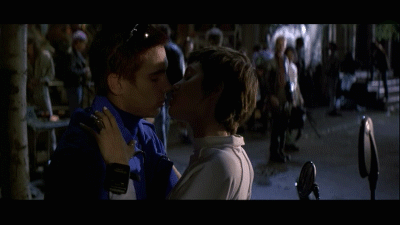
HC:
That's funny. Considering the story of Angelina and Johnny after the film, maybe that sense of disgust or that irksome quality that Jonny has in that scene is a whole lot less acting than originally thought.[laughs]
JB:
No. I think it was partly an acting thing where she was just giving him motivation. It may have just worked extra well.
HC:
The movie now has a very loyal cult following. What are your thoughts on that, and really how this film impacted the fans the way that it has?
JB:
I think it makes sense because I think it's a good film, it's an entertaining film. But also, it captures a point in time really well, that nobody else really was tapped into yet. I think that even though it's goofy and a bit of an exaggeration and over the top at times and that kind of thing, I think it's an accurate depiction of that world to a degree, or I think the characters in that movie I think are similar in personality to actual phone phreaks or actual hackers to an extent.
It's a very unique film. A lot of the credit goes to both Ian and John Beard for designing a really dynamic, really unique film. It moves, it's constantly entertaining, the performances are great. And I think it does capture the essence of hacking.
HC:
From your experience on the film, what stands out as the memory? If someone comes up and says "Hackers"?
JB:
Honestly, the memory that pops in mind, I don't think it's going to be very interesting or not- When Renoly Santiago looks out the window and there's all police cars downstairs. The whole street is filled with police cars. I remember we were moving really fast- and they're going to be ready to do that shot soon and we still had to put all those police cars in position.
I ran into a problem with my department because I let production assistants move cars because we were in such a hurry, and... you're not allowed to do that. I got yelled at by people in my own department and I learned about it. [laughs] But I don't think that's a very interesting story.
HC:
It is, though, right? With filming so much being union based, I think people will totally get it.[laughs]
JB:
I'm trying to think if there's anything else. The Angelina Jolie story is the one that always really pops into my mind, but I already told that one.
HC:
Jeff, thanks for your time. Any final thoughts for the fans?
JB:
Part of my impression of this whole thing is just surprise. When I worked on the movie, it really wasn't anything that I expected 25 years later people would be celebrating or there would be revived. It's interesting.
HC:
Jeff, thanks again. I can't say how much we appreciate it.
JB:
It's cool, man, thank you.


